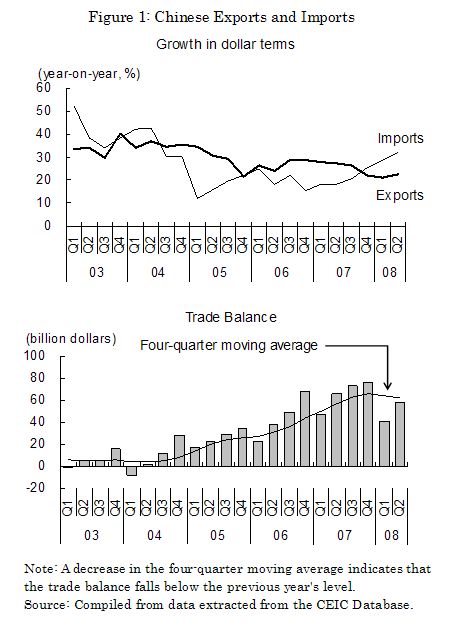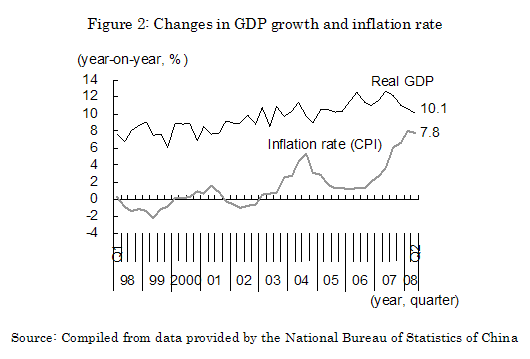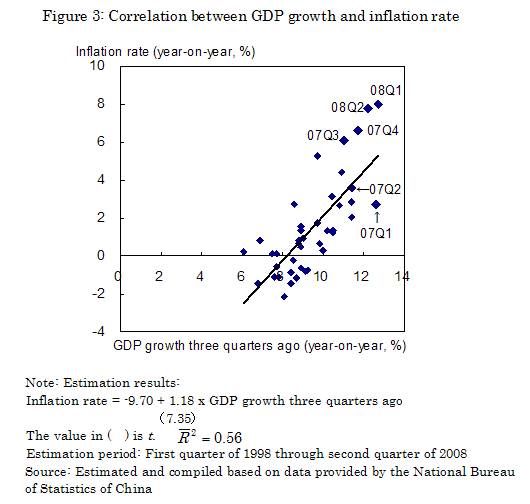Deepening signs of adjustment
The Beijing Olympics slated to begin August 8 are just around the corner. The prevailing view in Japan is that just like Japan at the time of the Tokyo Olympic Games, China will maintain its robust economy supported by strong investment and buoyant consumption in the run-up to the Olympic Games, but once the games are over the economy will lose momentum in a post-boom downturn. In reality, however, the Chinese economy is already in a moderate pullback even before the opening of the Olympic Games following the deterioration of economic conditions both at home and abroad. The Chinese economy grew by 10.1% in the second quarter of this year. This growth rate, though still at a high level, is down by 2.5 percentage points from the peak growth rate of 12.6% marked in the second quarter of 2007, and reflects a slowdown in both domestic and overseas demand.
First, on the demand side, China's export growth is slowing down and its trade surplus has begun to shrink (figure 1). In dollar terms, China's exports in the first half of 2008 expanded 21.9% year on year, falling below the 27.6% year-on-year growth posted in the corresponding six-month period in 2007. Furthermore, the real growth rate, discounted for a significant rise in export prices resulting from inflation and accelerated appreciation of the renminbi (RMB), is much lower than the nominal growth rate. Meanwhile, Chinese imports in the first half of 2008 posted a 30.6% year-on-year increase, outpacing exports by a considerable margin. The significant growth of imports is mainly attributable to rising prices of oil and other primary commodities, rather than being a result of growing domestic demand. With imports growing faster than exports, China's trade surplus, which had been rising consistently, has actually been falling below the previous year's level since around the beginning of 2008.

With respect to domestic demand, investment growth is slowing down while private consumption continues to grow, but its sustainability is questionable.
Capital investment in the first half of 2008 posted a 26.3% year-on-year increase in nominal terms, slightly outpacing its growth in the corresponding six-month period in 2007. However, the slowing growth is visible in real terms, excluding the rising price of investment goods (which increased 10% year on year). Amid the economic slowdown and the increased bias toward further monetary tightening, corporate earnings are hitting the wall and the cost of financing is rising. With all these factors taken into account, a further slowdown of investment spending is unavoidable.
Amid this situation, some people are voicing expectations that private consumption will replace investment as a driver of domestic demand, but it would be next to impossible to realize this. In fact, auto sales, a key factor boosting consumption, peaked in March and have since been on a downward trend, partly due to the influence of rising gasoline prices.
Future course of inflation subject to close scrutiny
Inflation is rising in China against the backdrop of robust economic performance to date, and expanding liquidity resulting from massive foreign exchange market interventions (buying U.S. dollars and selling RMB) to ease upward pressure on the RMB. The inflation rate, measured in terms of the consumer price index (CPI), stood at 7.9% year on year for the first half of 2008, which exceeded by far the 4.8% for 2007 as a whole.
As a means of controlling inflation, China's central bank has taken a series of monetary tightening steps including raising interest rates. However, an attempt to raise interest rates would induce even greater capital inflows from overseas investors in pursuit of higher returns, whereby the step intended to curb liquidity would actually end up increasing liquidity. Faced with this situation, China's central bank has begun to focus on allowing RMB to rise further - instead of raising interest rates - as a means to tighten liquidity. Indeed, an increase in the value of RMB would eventually trigger a shift from the current pattern of growth driven by overseas demand to one led by domestic demand. Over the short term, however, this will further dampen economic growth.
In China, there has been a tendency for the inflation rate (year-on-year growth rate of CPI) to trail the movement of the economic growth rate (year-on-year) with a lag of about three quarters (figure 2). Recently, the inflation rate declined somewhat in the second quarter of 2008 after peaking in the first quarter, emulating the movement of the gross domestic product (GDP) that peaked in the second quarter of 1997 and turned downward thereafter. Based on data since 1998, it is estimated that an increase (decrease) of one percentage point in the growth rate will be followed by an increase (decrease) of 1.18% in the inflation rate three quarters later (figure 3). As such, an economic slowdown is a prerequisite for taming inflation.


Downward spiral of equity and real estate prices must be watched closely
In contrast to the rising inflation, Chinese share prices have been falling sharply since October 2007, and the recent robust real estate market is beginning to show signs of a turning tide. Since the latter half of 2005, Chinese equity and real estate prices have risen concurrently, boosting each other in an upward spiral. However, concerns are now being raised that the recently steep decline in stock prices may turn this upward spiral into a downward one.
Against the backdrop of increasing liquidity coupled with the progress of non-tradable share reform launched in the spring of 2005, Chinese share prices soared to a level above 6,000 points in mid October 2007, when the 17th National Congress of the Communist Party of China (CPC) was held, multiplying six times in 28 months from a level of 1,000 points in June 2005. However, around this same time period share prices in the world's major markets began to fall sharply following the outbreak of the subprime mortgage crisis in the United States. In the initial stage resulting Chinese stock market corrections were modest and this so-called "decoupling" phenomenon - in which China was in the midst of its high growth and appeared immune to the impact of overseas economic conditions - has drawn much attention. However, as the impact of the U.S. subprime mortgage problem spread beyond the financial markets to affect real economies across the world, the global stock meltdown has finally reached the Chinese market. Particularly from mid January 2008 onward, the Shanghai Stock Exchange Composite Index has fallen conspicuously and has hovered at levels below 3,000 points since June 12.
In addition to the global stock meltdown, the following three domestic factors also contributed to the downward slide of Chinese stock prices.
First, share prices of Chinese enterprises have been deviating far from the underlying fundamental value of these enterprises. During the course of the upward trend in stock prices that began in June 2005, the earnings performance of Chinese enterprises did improve substantially. However, stock prices were rising far faster than earnings, resulting in the price-earnings ratios (PER) jumping from 20 in 2005 to 70 in October 2007, a level comparable to that of Japanese stocks in the latter half of the 1980s when Japan was at the peak of its asset bubble. A sharp fall in stock prices can be interpreted as a process in which stock prices that have been driven by irrational exuberance return to levels that are commensurate with the earnings performance of respective enterprises. Today, with the PER coming down to 20, the problem of overvaluation has been largely resolved.
Second, the supply-demand balance in the Chinese stock market has been deteriorating. The non-tradable share reform from the spring of 2005 has established a system under which most non-tradable stocks - which previously accounted for 70% of the outstanding shares issued in China - become freely tradable once a designated lock-up period expires. The lock-up period for a large number of non-tradable shares is soon to expire. When formerly non-tradable state- and enterprise-owned shares become tradable and are sold in large volume on the open market, it will have a depressing effect on stock prices just like the "unwinding of cross-shareholding" did in Japan.
Third, against the backdrop of accelerating inflation, the monetary authorities are tightening their policy stance. Higher interest rates and quantitative restrictions on bank lending are pushing up the cost of financing for enterprises, thereby squeezing their earnings.
Against the backdrop of such monetary tightening and sharp falls in stock prices, real estate prices, which have been on a consistent rise, are coming to a turning point. The index of real estate prices in China's 70 large and mid-sized cities posted an 8.2% year-on-year increase in June, slowing from its peak growth of 11.3% in January yet remaining unchanged on a month-on-month basis. As such, the adjustment trend is becoming more evident. Furthermore, the number of completed contracts for built-for-sale housing is dropping sharply in major cities such as Beijing, Shanghai, and Shenzhen, indicating that real estate prices are coming under stronger downward pressure.
Toward soft-landing
As shown by Japan's experience, when the real estate bubble bursts along with the stock bubble, portions of bank loans become irrecoverable and the resulting rise in banks' nonperforming loans leads to a credit crunch. Falling stock prices also mean erosion in the value of assets held by investors, dampened consumption, and increased financing costs for enterprises. In this situation, investment spending is bound to slacken off, which, combined with the slowdown of the world economy and surging crude oil prices, will inevitably cause an adjustment that may last for another year or so.
Concern has been voiced that China could fall into a long-term stalemate, just as Japan slipped into its "lost decade" in the 1990s following the burst of its bubble. However, this scenario seems unlikely because China is an "emerging economy" and the current state of the Chinese economy, with its potential growth rate estimated to be as high as about 10%, resembles more to that of Japan in the 1960s than in the 1990s. Thus, China is expected to make a strong recovery after a relatively short phase of adjustment, just like Japan after the 1964 Tokyo Olympic Games.
When signs of easing inflation begin to show in the slowing economy, the monetary authorities will shift their policy stance from tightening to easing and provide momentum for recovery. However, it is necessary to closely monitor some risk factors that may render such a soft-landing scenario impossible - namely, to what extent real estate prices will fall, and how long the world economy will remain stagnant.


